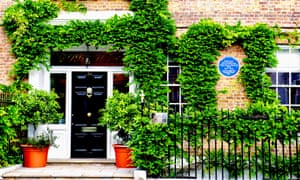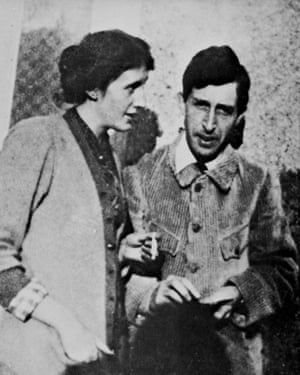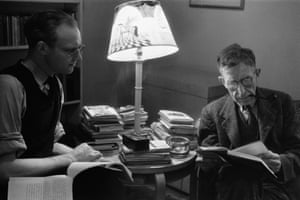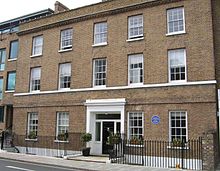A publisher of one's own: Virginia and Leonard Woolf and the Hogarth Press
A century after the Bloomsbury luminaries took delivery of their own printing equipment, the legacy of their pioneering – and often dramatic – DIY operation lives on

Hogarth House in Richmond, where Virginia and Leonard Woolf founded the Hogarth Press on 24 April 1917. Photograph: Alamy Stock Photo
Monday 24 April 2017 15.15 BSTLast modified on Monday 24 April 2017 18.41 BST
“We unpacked it with enormous excitement, finally with Nelly’s help carried it into the drawing room, set it on its stand, and discovered that it was smashed in half,” wrote Virginia Woolf on the afternoon of 24 April 1917. That day she and her husband Leonard took delivery of the hand press that heralded the birth of their brainchild, the Hogarth Press. Their £19 purchase had been long awaited, one of three resolutions made while the couple took tea on Virginia’s 33rd birthday: they would buy Hogarth House in Richmond, find a hand press to do their own printing, and buy a bulldog and name him John.
The missing part needed to fix the press and render it operative arrived several weeks later and the first publication notice, painstakingly hand set by the Woolfs, was sent out in May. In tidy lettering, it bravely announced the imminent publication of a pamphlet titled Two Stories: one each by Virginia and Leonard.

FacebookTwitterPinterest The Woolfs, photographed in 1914. Photograph: Alamy Stock Photo
So the Hogarth Press was born, and like all parents the Woolfs declared their lives changed forever. The publishing business that the two set up in their drawing room and which would eventually to take up their dining room, then much of their lives, was supposed to be an answer to so much. It was a physically engrossing activity to ease Virginia’s crippling anxiety, a business that could potentially free the couple from the whims of publishers and even a social outlet through which their diverse literary friendships could be monetised.
It almost lived up to all these weighty expectations. Those first afternoons, when Leonard and Virginia sat covered in ink in the drawing room of Hogarth House, learning by trial and error just how hard it was to set type and centre it on the page, were charmed ones. The experience was a simulacrum of the creative process: the beloved final product did not always reflect the pains of its production.But the labours of printing always delivered the satisfaction of a real and tangible object.
The press also fulfilled a desire for creative freedom that both Leonard and Virginia had craved. Virginia had long resented relying on her half-brother Gerald Duckworth to be her publisher. He was a man who, in her words, could not tell “a book from a beehive” and had no interest in avant garde writing. (Woolf would also later accuse him of molesting her when she was a child.) The acute anxiety she felt when waiting for answers from publishers was partially eliminated by Hogarth. Leonard, while happy to have cut out the middle-man, also revelled in the new venture, declaring in a letter: “I should never do anything else, you cannot think how exciting, soothing, ennobling and satisfying it is.”
Virginia's lover Vita Sackville-West demanded more money from the Woolfs... she got the money, but lost Virginia
He was right. Leonard’s commitment to the press would be lifelong, carrying on through the interwar period and then the second world war and even after Virginia’s tragic death. What started as a hobby would become a vocation and, in later years, his sole source of income. If Leonard’s involvement was steady, Virginia’s was mercurial, waxing and waning through her depressive and creative spells. As early as March 1924, as they got ready to publish her novel Jacob’s Room, she declared in a letter that “publishing one’s own books is very nervous work”. By October 1933, when Hogarth Press turned 16, Virginia declared herself tired of the “drudgery and sweating” and the “altered travel plans” that running the publisher required. She demanded that an “intelligent youth” be found to take over its day-to-day operations.

FacebookTwitterPinterest Leonard Woolf, pictured reading with the poet John Lehmann, who was managing director of the Hogarth Press between 1938 - 1946. Photograph: Hulton Deutsch/Corbis via Getty Images
No youth was found but the press plodded along, continuing its early practice of converting friends into Hogarth authors. This too was laden with complication, at least for Virginia. The second book that Hogarth published was Katherine Mansfield’s Prelude, the production of which caused tension in their friendship. In 1934, Virginia would declare her affair with Vita Sackville-West over because of her intense dislike of the latter’s new novel The Dark Island. The book was still published by Hogarth, but only after protracted and awkward negotiations in which an embarrassed Sackville-West demanded more money from the Woolfs, who had chosen to ignore her previous hints towards a more lucrative contract. She got the money, but she lost Virginia. The whole episode was a fitting indictment of the inevitable acridity of lover-publisher unions.
Advertisement
The Hogarth Press ran until 1946 and, in 29 years, published 527 titles. Precisely a century on, the house is one of many imprints making up thegiant publisher Penguin Random House. That Hogarth has reached this milestone is a considerable achievement; as JH Willis writes in his book on the press, many small presses were birthed in the interwar period – and most perished. But beyond the obvious victory of its survival, the Hogarth story reveals much about publishing and the transformations wrought when writers change sides in the game of literary creation.
Virginia and Leonard both discovered that the limitations of publishers, their one-time oppressors, were now their own. In one striking instance, very early in the life of the press, the Woolfs wrote to James Joyce to reject his manuscript of Ulysses. It was too long and beyond their fledgling capabilities, the Woolfs declared in their letter. It was just the sort of statement they would have resented and mistrusted as writers. But they were publishers, now - and so they made it anyway.
【Simon管理行為】中提到S. Freud 有四處:最多是談到 organizational identification部分。
81頁註解可知
{無意識}( The Unconscious)的出自 Freud的【文集】(The Collected Papers),1925年,London: L and V WOOLF出版社。
奇怪的是,出版社的名稱非The Hogarth Press was a British publishing house founded in 1917 by Leonard Woolf and Virginia Woolf.
From Wikipedia, the free encyclopedia
 | |
| Status | Owned by Random House |
|---|---|
| Founded | 1917 |
| Founder | Leonard Woolf and Virginia Woolf |
| Successor | Chatto & Windus |
| Country of origin | United Kingdom |
| Headquarters location | London |
| Publication types | Books |
The Hogarth Press was a British publishing house founded in 1917 by Leonard Woolf and Virginia Woolf. It was named after their house in Richmond, in which they began hand-printing books.
During the interwar period, the Hogarth Press grew from a hobby of the Woolfs to a business when they began using commercial printers. In 1938 Virginia Woolf relinquished her interest in the business and it was then run as a partnership by Leonard Woolf andJohn Lehmann until 1946, when it became an associate company ofChatto & Windus. "Hogarth" is now an imprint of The Crown Publishing Group, part of Random House Inc.
As well as publishing the works of the members of the Bloomsbury group, the Hogarth Press was at the forefront of publishing works onpsychoanalysis and translations of foreign, especially Russian, works.
Contents
[hide]History[edit]
Printing was a hobby for the Woolfs, and it provided a diversion for Virginia when writing became too stressful. The couple bought a handpress in 1917 for £19 (equivalent to about £900 in 2012) and taught themselves how to use it. The press was set up in the dining room of Hogarth House, where the Woolfs lived, lending its name to the publishing company they founded. In July they published their first text, a book with one story written by Leonard and the other written by Virginia.[1]
Between 1917 and 1946 the Press published 527 titles.[2]
| Number of publications by year from 1917 to 1946[3] | ||||||||||||||||||||||||||||||
|---|---|---|---|---|---|---|---|---|---|---|---|---|---|---|---|---|---|---|---|---|---|---|---|---|---|---|---|---|---|---|
| Year | 1917 | 1918 | 1919 | 1920 | 1921 | 1922 | 1923 | 1924 | 1925 | 1926 | 1927 | 1928 | 1929 | 1930 | 1931 | 1932 | 1933 | 1934 | 1935 | 1936 | 1937 | 1938 | 1939 | 1940 | 1941 | 1942 | 1943 | 1944 | 1945 | 1946 |
| Titles published | 1 | 2 | 5 | 3 | 6 | 9 | 14 | 14 | 28 | 31 | 42 | 30 | 30 | 30 | 34 | 36 | 20 | 21 | 24 | 23 | 20 | 17 | 23 | 12 | 13 | 12 | 7 | 10 | 4 | 4 |
| Profit generated by the Hogarth Press publication (without bonuses and salaries)[4] | ||||||||||||||||||||||||||||||
|---|---|---|---|---|---|---|---|---|---|---|---|---|---|---|---|---|---|---|---|---|---|---|---|---|---|---|---|---|---|---|
| Year | 1917–18 | 1919 | 1920 | 1921 | 1922 | 1923 | 1924 | 1925 | 1926 | 1927 | 1928 | 1929 | 1930 | 1931 | 1932 | 1933 | 1934 | 1935 | 1936 | 1937 | 1938 | |||||||||
| Profit | £13 8s 8d | £13 14s 2d | £68 19s 4d | £25 5s 6d | £10 6s 4d | £5 7s 8d | £3 17s 0d | £73 1s 1.5d | £26 19s 1d | £64 2s 0d | £380 16s 0d | £580 14s 8d | £2,373 4s 2.5d | £2,209 0s 1.5d | £1,693 4s 1d | £929 15s 2.5d | £516 13s 0d | £598 7s 2d | £84 5s 0d | £2,422 18s 5d | £35 7s 7d | |||||||||
Notable title history[edit]
- Monday or Tuesday by Virginia Woolf, with woodcuts by Vanessa Bell
- The Devils (1922) by Dostoyevsky – translated by Virginia Woolf herself
《群魔》(俄語:Бесы、Demons、The Possessed)係俄國作家陀思妥耶夫斯基的長篇小說,另譯為《附魔者》,發表於1872年左右,有上下兩部。
概要[編輯]
書名是引用《新約·福音書》第八章32-36節耶穌在格拉森驅除號稱為「群」的惡鬼,小說內容描寫在亞歷山大二世時代的俄國革命,對於俄國彌漫著無神論的論調感到憂心,他預言喪失信仰後,俄羅斯民族即將走向毀滅。《群魔》一書中有一話,後來成為陀思妥耶夫斯基的名言:「人之所以不幸,是因為他不知道他是幸福的;僅僅是這個原因。這就是一切,一切!誰要是明白了這一點,他此時此刻馬上就會變得幸福起來。」

Leonard Woolf was born on this day in 1880. In Sowing (1960), the first volume of his autobiography, Woolf describes his first glimpse of eighteen-year-old Virginia Stephen, accompanied by her sister, Vanessa: "I first saw them one summer afternoon in Thoby's rooms; in white dresses and large hats, with parasols in their hands. Their beauty literally took one's breath away.... They were at that time, at least upon the surface, the most Victorian of Victorian young ladies, and today what that meant it is almost impossible to believe or even remember.... Virginia and Vanessa were also very silent and to any superficial observer they might have seemed demure ... [but] the observant observer would have noticed at the back of the two Miss Stephens' eyes a look which would have warned him to be cautious, a look which belied the demureness, a look of great intelligence, hypercritical, sarcastic, satirical." Source: http://ow.ly/r9mnF
*****
www.lib.udel.edu/ud/spec/exhibits/hogarth/comercl.htm - 頁庫存檔
Special Collections Department
HOGARTH PRESS: COMMERCIAL PUBLICATIONS
The commercial publications of the Hogarth Press also bear the unique stamp of the owners. As with the handprinted books, these commercially produced imprints include works by themselves, the Bloomsbury Group, and others they wished to promote, and covered the wide range of subjects that were of interest to the Woolfs.Among their own works which they had printed commercially were Virginia's To the Lighthouse (1927) and A Room of One's Own (1929), and Leonard's essay, Fear and Politics (1925), and his play, The Hotel (1939). Other notable works published commercially by the Woolfs include Edwin Muir's first book, First Poems (1925), William Plomer's Sado (1931), and Christopher Isherwood's Sally Bowles (1937). Also included among the commercial works in the Special Collections Department are the only known copy of the "First Proof" of Harold Nicolson's Jeanne de Hénaut (1924), with the author's name misspelled; and a review copy of Geoffrey Phibbs's The Withering of the Fig Leaf (1927), which the author persuaded Leonard Woolf to suppress because of its anti-Catholic tone, with a letter requesting that no review be submitted.
As small, independent publishers, the Woolfs had more freedom than larger, commercial firms to publish what and whom they liked and to maintain quality in their selections. The Press also provided the Woolfs with what most authors only dream of -- control over the publisher. This was especially important for Virginia, allowing her to experiment as she pleased. With technical support provided by commercial printers, the Woolfs were able to sustain their personal publishing program with remarkable consistency. The Hogarth Press, viewed from the perspective of this anniversary exhibit, is a unique and significant part of twentieth-century literary, artistic and cultural life.
"I was always going to the bookcase for another sip of the divine specific. Therefore, I let fly my tremendous battery of phrases upon somebody quite inappropriate—a girl now married, now buried; every book, every windowseat was littered with sheets of my unfinished letters to the woman who made me Byron."
--from THE WAVES
--from THE WAVES
The Waves is often regarded as Virginia Woolf's masterpiece, standing with those few works of twentieth-century literature that have created unique forms of their own. In deeply poetic prose, Woolf traces the lives of six children from infancy to death who fleetingly unite around the unseen figure of a seventh child, Percival. Allusive and mysterious, The Waves yields new treasures upon each reading.
EDWIN MUIR.
First Poems. 1925.
This is Edwin Muir's first book.
"I look back on this forty year's connection with Edwin Muir with great pleasure and some sadness. We printed his poems in 1925 . . . and he was the kind of author and they were the kind of poems for whom and which we wanted the Press to exist. . . . the sadness comes from a feeling that life dealt rather hardly with him."
Leonard Woolf, Downhill All the Way (1967).
LEONARD WOOLF.
Fear and Politics. 1925.
The Hogarth Essays, First Series, No. 7
JOHN MAYNARD KEYNES.
The End of Laissez-Faire. 1926.
"I ought to have written to you before. . . . We have been in rather a rush, though, bringing out a book of Maynard Keynes'."
Virginia Woolf to Violet Dickinson, July 26, 1926.
VIRGINIA WOOLF.
To The Lighthouse. 1927.
Jacket designed by Vanessa Bell.
"Book out. We have sold (I think) 1690 before publication - twice Dalloway. I write however in the shadow of the damp cloud of the Times Lit[.] Sup. [Times Literary Supplement] review, . . . leaving me moderately depressed. . . . Yet, honestly don't much care; want to be let alone to ruminate."
Virginia Woolf, from her diary entry for May 5 1927.
VIRGINIA WOOLF.
Orlando. 1928.
"And instantly the usual exciting devices enter my mind: a biography beginning in the year 1500 & continuing to the present day, called Orlando: Vita; only with a change about from one sex to another."
Virginia Woolf, from her diary entry for October 5, 1927.
"But listen; suppose Orlando turns out to be Vita; and its [sic] all about you and the lusts of your flesh and the lure of your mind. . . . Shall you mind?"
Virginia Woolf to Vita Sackville-West, October 9, 1927.
SYLVA NORMAN.
Nature Has No Tune. 1929.
"Julian [Bell] dines with us tonight to meet Miss Sylva Norman whom I fetched up from complete nonentity on the telephone last night. Another marvel of science. There she was in 10 minutes after we thought of her saying she would LOVE to come. . . . They will dine with us; & that is what I am ripe for - to go adventuring on the streams of other peoples [sic] lives - speculating, adrift[.]"
Virginia Woolf, from her diary entry for June 20, 1928.
VIRGINIA WOOLF.
A Room of One's Own. 1929.
First trade edition. Jacket designed by Vanessa Bell.
"By the way, the sales of A Room are unprecedented - have beaten Orlando; feels like a line running through ones [sic] fingers; orders for 100 taken as coolly as 12's used to be. We have sold, I think 5500; & our next years [sic] income is made."
Virginia Woolf, from her diary entry for December 14, 1929.
E. J. LANGFORD GARSTIN and HUGH J.SCHONFIELD (eds.).
The Search, A Quarterly Review. Volume 1, Number 1. January, 1931.
Only four issues of The Search were published between January and October 1931 (Volume 1, Numbers 1-4). The relationship between the editors and Leonard Woolf was not smooth and the Hogarth Press published only the first two issues.
"The Search aims at presenting its readers, in form as readily assimilable as possible, with the researches and conclusions of modern scholarship in the domains of Religion, Philosophy, Science, Literature and Art." From inside front cover.
LEONARD WOOLF.
Quack, Quack! 1935.
"Leonard has just finished his book, called Quack Quack which will be out in June. I expect it will get him into hot water with all classes, as it is a very spirited attack upon human nature as it is at present. I think you'll enjoy it."
Virginia Woolf to Margaret Llewelyn Davies, April 28, 1935.
CHRISTOPHER ISHERWOOD.
Sally Bowles. 1937.
Jacket designed by Richard Kennedy.
"I was fascinated by it [the story of "Sally Bowles"] . . . but . . . I was worried about the abortion episode, and wondered whether, in the climate of those days, our printers would pass it. . . . Sally Bowles was eventually published, with what struck me as considerable courage, in its little separate book by Leonard and Virginia at the Hogarth Press."
John Lehmann, Thrown to the Woolfs (1978).
LEONARD WOOLF.
The Hotel. 1939.
"In 1938 I wrote a play, The Hotel, about the horrors of the twilight age of Europe, the kind of hush that fell upon us before the final catastrophe. . . . It was written in the tension of those horrible years of Hitler's domination and of the feeling that he would inevitably destroy civilization."
Leonard Woolf, Downhill All the Way (1967).
VIRGINIA WOOLF.
Between the Acts. 1941.
Jacket designed by Vanessa Bell.
"I'd decided before your letter came, that I cant [sic] publish that novel as it stands - its [sic] too silly and trivial.
"What I will do is to revise it, and see if I can pull it together and so publish it in the autumn. If published as it is, it would certainly mean a financial loss; which we dont [sic] want. I am sure I am right about this."
Virginia Woolf to John Lehmann, ca. March 27, 1941.
It was never revised. Virginia Woolf committed suicide on March 28, 1941. Between the Acts was published without the intended changes in July of that year, with only slight spelling and textual corrections.
"The only other thing I could do for Virginia was to see Between the Acts through the press at Letchworth: correct the proofs with Leonard, choose the binding, have the jacket prepared by Vanessa, see to the Canadian edition, compose the publicity letters and design advertisements. When it came out, in the third week of July, it was treated as a masterpiece."
John Lehmann, Thrown to the Woolfs (1978).
HENRY GREEN.
Loving. 1945.
Jacket designed by John Piper.
"The arrival of Henry Green as a Hogarth author seemed to me to start a new phase, and gave me confidence for the future. . . . During the war Henry produced in rapid succession a series of brilliant books, more than justifying my belief in him. He also became a much-treasured friend, vivacious and endlessly witty and amusing."
John Lehmann, Thrown to the Woolfs (1978).
| Introduction | Hand Printed | Translations | Series | The Present |






沒有留言:
張貼留言